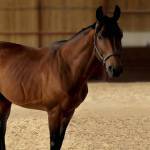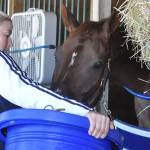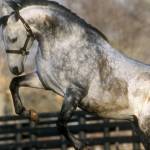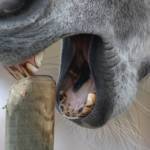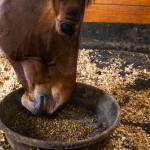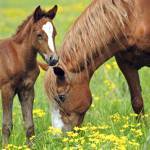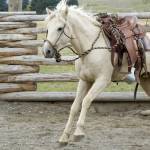Is My Horse the Right Size?

Everyone has seen pictures of a smiling child perched high on the back of a huge, placid workhorse. Equally familiar is the stereotype of a tiny burro carrying a portly owner to the village market. Both images provoke smiles from viewers, but neither portrays the best match between mount and master.
How can a rider decide what size equine is right? To answer this question, it is necessary to consider several factors about both the rider and the horse. From the standpoint of the rider, think about these things:
Age An adult owner is not likely to have significant changes in size, weight, or strength. Therefore, an adult can buy a horse and expect to keep it for several years. A small child has a short attention span, does not learn riding skills as quickly as an older horse owner, and will grow significantly taller, heavier, and stronger in the course of a few years. While parents usually don’t want to buy a pony that a child will quickly outgrow, neither should they look for an extremely large equine. A small child can have a more secure seat if his or her legs reach well down a pony’s sides.
Height The rider’s absolute height is important, but proportion also makes a difference. Two riders who are the same height may have a large variation in the relative lengths of legs and torso. Getting on the prospective mount is the only way to judge the “fit” of horse and rider. In general, the rider should not be so tall as to look top-heavy on the horse, and the rider’s feet should not hang much lower than the horse’s belly when the stirrups are adjusted properly.
Weight Rider and tack should not total more than about 20% of the horse’s weight. Ponies can carry proportionally more weight than horses, usually up to 35 or 40% of their weight. Obviously, a heavier rider will need a larger, heavier horse.
Strength Riders control their horses less by power than by finesse and training, but a certain amount of strength and agility is still necessary. A very tall horse is harder for a child or small adult to mount and dismount. Leg and rein aids may be applied using only a small proportion of an adult’s strength, but a child may have to kick and pull with full power to get the desired effect. This can make riding a big horse very tiring for a child, with the added detriment that the child who rides a very large equine is likely to develop the habit of roughness when riding or working around horses.
Intended use As stated earlier, horses can carry about 20% of their weight. However, when figuring the weight to be moved if a horse is being driven or worked in harness, these percentages can be approximately doubled. Level and duration of work are also important. Polo ponies typically weigh 900 to 1000 pounds and may carry somewhat more than 20% of their weight. Although their work is intense, it is not sustained for a long period of time. Endurance horses, on the other hand, may be ridden for many hours during a long race, and a lighter rider will help them carry out this work with minimal fatigue.
For the horse, take these factors into consideration:
Breed Ponies are obviously smaller than their tall cousins, but they also tend to have heavier muscling, more substantial legs, and a shorter back in proportion to their size. These attributes allow them to carry and pull heavier loads in relation to their weight. However, because ponies are defined by height (any equine measuring 14.2 hands or less is technically a pony, regardless of breed), some small Thoroughbreds fall into this category while still sporting the finer body and bone of a racehorse. Though classified as ponies, these animals will not have the typical pony’s ability to carry a large rider.
Temperament A horse or pony’s temperament is often closely tied to breed. Although a pony may be visually appealing and a good size match for a very small child, ponies have a well-earned reputation for having minds of their own. Until they acquire some riding skill, many children will be safer and happier on a taller mount with a more cooperative attitude. It’s hard to beat a mature or even slightly elderly Quarter Horse as the steed of choice for a beginning rider of almost any size or age.
Conformation In general, horses that are wider through the loin area (back and barrel just in front of the hind legs) will be able to carry more weight. Most pony and draft breeds fall into this category, as do many Tennessee Walking Horses and American Saddlebreds. Besides body type, conformation of the leg bones and joints is extremely important. A horse with crooked, offset, or weakly muscled legs is less likely to stay sound as his workload increases. Moderately large, well-formed hooves will support the horse’s body better than small, shallow, weak hooves.
Age Horses grow and develop until the age of about four. Younger horses that are asked to work and carry weight will probably not have as many useful years as those allowed to mature before entering heavy work. Most horses can perform well until their late teen years. Arthritis and general wear and tear begin to affect performance by this age, although many older horses are still useful if their workload is not too strenuous. Ponies seem to have both a longer life and more years of full use than their full-sized counterparts.
Condition Horses in regular use or training will obviously be able to perform longer and more efficiently than “pasture potatoes” or those that are ridden only occasionally. Just like people, overweight horses and ponies will tire more quickly and be in more danger of muscle strain or injury than those in athletic shape.
Training As a horse becomes more skilled in his particular type of work, he will be able to perform with less effort. For instance, a barrel racer, jumper, or dressage horse that is beginning his career will expend more energy at a lower level of performance than the same horse who, after years of experience, has developed the strength and balance to help him do his job with no wasted energy. A trained horse that knows the best way to use his body can carry more weight than a horse that is a novice in his discipline.
Size has an influence on feed requirements, and in general larger horses need more feed than smaller animals. However, hot-blooded horses (Thoroughbreds, for example) tend to need somewhat more feed for their size than warmbloods, ponies, or draft horses. Heavier-built horses and those with placid temperaments usually require proportionally less grain, and some easy-keeping horses must have their access to pasture restricted to avoid overconsumption of lush grass. Feed management must be determined by the horse’s size, use, metabolism, and current weight.

